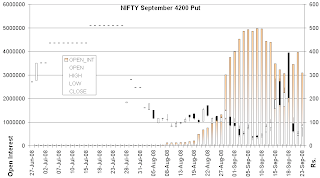The U.S. economy had taken a downturn in 1906. At Princeton University, the school's president, Woodrow Wilson, attributed the country's economic troubles to the government's "aggressive attitude toward the railroads, that made it impossible for them to borrow." President Teddy Roosevelt was under fire from the business community who urged him to ease up on regulatory measures and antitrust prosecutions. Instead, Roosevelt threatened at the end of 1906 to subject all large trusts to federal control. Americans were enjoying "a literally unprecedented prosperity," he said, ignoring the storm clouds on the horizon. In her book "Morgan: American Financier," author Jean Strouse writes of this time and J.P.'s emerging role in the spring of 1907. "Morgan planned to leave for Europe in mid-March 1907, but the combination of monetary shrinkage [largely due to financing of the Boer and Russo-Japanese Wars] and a rumor that Roosevelt would make some dramatic new move against the railroads called him out of his 'Up-Town Branch.' He went to Washington on March 12 and spent two hours discussing 'the present business situation' with the President. As he left the White House he told the press that Roosevelt would soon meet with the heads of leading railroads to see what might be done to 'allay public anxiety.'" On March 12, the Dow Jones Industrial Average stood at 86.53. On March 13, the stock market began to fall and closed that day at 83.12. Morgan sailed for Europe. On March 14, the market crashed, losing 8.3% of its value (DJ 76.23). The next six months saw the market steadily erode. Then on October 21, a run developed on The Knickerbocker Trust Co. of New York (this was before the signing of Latrell Sprewell). According to author John Steele Gordon, "Depositors lined up in front of the bank's headquarters on the future site of the Empire State Building to demand their funds. The bank closed the next day after an auditor found that its funds were depleted beyond hope. The bank's president, Charles Barney, shot himself several weeks later, prompting some of the bank's outstanding depositors to commit suicide as well." After this fiasco, J.P. Morgan and his Wall Street cronies put together a rescue package designed to prop up the other trust institutions. The group got together with Teddy Roosevelt's Treasury Secretary, George Cortelyou, who provided them with $25 million to keep the system from collapsing. The funds were then deposited in the national banks in New York with the intent of adding funds to a system sorely in need of more liquidity. The banks were to apply the funds as they saw fit to prevent further panics. [On October 21, the Dow closed at 60.81…it would bottom at 53.00 on November 15, a decline of 39% since March 12] Roosevelt had tremendous faith in Morgan. But it was extraordinary that the Treasury of the largest emerging economy in the world had to transfer funds to private bankers in order to prevent a financial collapse. The rumor was rampant that the bankers had orchestrated most of the panic themselves in order to make speculative profits. After the Knickerbocker failure came the Trust Co. of America. Morgan organized a $3 million pool to save it. The bailout worked and a measure of confidence was restored. The $25 million pool from Treasury was parceled out as needed and it kept the stock market from totally collapsing, though imagine the chagrin today if the Dow fell from 11400 to 7000 (39%). But the stock exchange continued to be weighed under by all of the margin selling. [Today, margin debt is soaring, up 46% over last year's high levels.] On October 24, the NYSE President, "Pay Me" Ransom Thomas, pleaded with Morgan to provide $25 million in funds to back the exchange, fearing it would not be able to remain open that day if help was not forthcoming. Morgan and the bank presidents responded quickly, pledging the funds, and the NYSE was able to remain open. Gordon writes that "when the support package was announced, pandemonium broke out on the exchange. Morgan heard a thunder of noise at his office across the street. It was the members of the NYSE giving him an ovation." Morgan was hailed as the savior of the banking system, the stock exchange, and even New York City at the time. [Morgan had engineered a bailout package for NYC also in October. The city was in the throes of a depression with the market slide and bank failures which forced the city's back to the financial wall. Morgan agreed to underwrite a successful $30 million bond issue]. Of course Morgan did not go unrewarded. Recall from our story of two weeks ago that Teddy Roosevelt, despite his antitrust proclivities, allowed Morgan to purchase the Tennessee Coal and Iron Company for about $45 million when the true value was closer to $700 million, thus expanding Morgan's steel empire.
........................... Click here to read more!
"Blood
Monday, 29 September 2008
J.P. Morgan - Savior -- The Panic of 1907
Wednesday, 24 September 2008
Tuesday, 23 September 2008
OI Charts - Nifty September Puts/Calls - 22 September 2008
........................... Click here to read more!
Sunday, 14 September 2008
Nifty Shorting Setup

........................... Click here to read more!
Saturday, 13 September 2008
Invest in what India needs
----- With due apologies and full credits to livemint dot com
........................... Click here to read more!
Tuesday, 9 September 2008
Highest Volatility Stocks
SYMBOL CASH QUANTITY TRADED CASH ANNUALIZED VOLATILITY FUTURES ANNUALIZED VOLATILITY IBREALEST 4776164 123.475554 125.024443 RANBAXY 2764538 65.920491 116.514486 FSL 1958032 104.254926 102.467203 HDIL 3677208 99.582945 102.176732 NOIDATOLL 1147979 95.397913 95.985889 INDIAINFO 1578541 89.867503 94.215517 KOTAKBANK 1709104 90.230179 90.312429 ORBITCORP 423085 87.789115 89.242916 AIRDECCAN 1094402 85.691003 87.868163 WALCHANNAG 1488927 86.088491 87.285421
........................... Click here to read more!
OI Charts - Nifty September Puts/Calls
Some minor buildup in 4600 puts. 4500 puts added over 6 lac puts. 4400 puts added whooping 9 lac puts.
........................... Click here to read more!

















































